|















|
|
Moslem
Architecture
|
The Mohammedan (Islamic) architecture of
Bosra, that is the mosques and the Castle, is almost all of the later
Mediaeval period. The mosques are the earlier; most of them being
apparently of the 12th. century. There is an undated inscription in
the Djâmi il-OmarI, in Cufic characters that may be of the 9th. or
10th. century. Another Arabic inscription mentions four inns that were
built in 561 A. H., that is 1165—66 A.D. The Castle belongs
unquestionably to the 13th. century. The mosques inside the walls, of
which there are ruins, or other records, were eight in number as
follows: the Djami il-Omari or the great Mosque, the Djami il-Khidr,
the Djami Fatmeh, the Djami il-Mebrak, and id-Dabbaghah, all of which
are given in red on the Plan of Bosra, a small tomb mosque beside the
Birket il-Hadjdj, near id-Dabbaghah, which bears a dated inscription
of the year 654 A. H. or 1256 A. D., the little mosque in the Castle,
and the Djami' il-Kandil, or "Mosque of the Candlestick", which is
known only from being mentioned in an inscription of the year 561 A.
H., 1165-66 A. D.; but which was, in all probability, situated near
the Central Arch which is still called il-Kandil by the natives; the
arch perhaps formed the front of the mosque, and the ruins to the
south of it may be the ruins of the Djami' il-Kandil. As I have said
in the introduction to this part, the construction of mosques in Bosra
followed the ancient methods of construction that had been known in
the Hauran for at least seven hundred years before the Hegira. The
leading structural principle in all is the principle of the
girder-arch and the flat roof of stone slabs. The ground plans vary
greatly, there are round arches and pointed arches; but the ancient
arch-and-slab construction obtained in all. Two at least of the later
mosques could boast of domes, as we learn from earlier writers; but
the dome was used in connexion with the old system of roofing Almost
all of these buildings were built of second-hand materials and, for
that reason, they are difficult to date wherever inscriptions are
lacking; and the use of ancient carved ornament in a slovenly and
unsystematic manner, while lending a sort of pictu-resqueness to the
mosques as ruins, detracted from their beauty as monuments of Islamic
architecture.
DjAMl' IL-OMARI or MOSQUE OF OMAR. The great mosque of
Bosra has been mentioned in the notes of many travellers. M. Rey gives
an unsatisfactory plan of the building, and others have published
photographs, the best of which are those of Brunnow and of Kondakow .
This mosque is generally believed to have been erected |
|
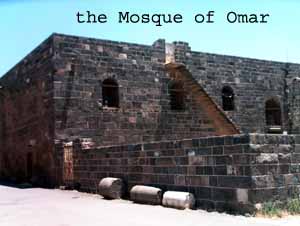 |
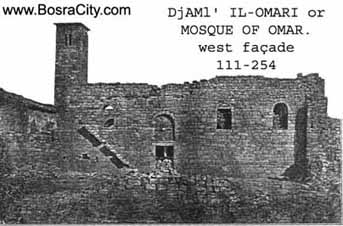 |
|
by the Khalif Omar ibn al-Khattab. The
undated inscription in the building, which I mentioned above,
may be as early as the 9th. or 10th. century; another
inscription of the year 506 A. H. (1112-13 A. D.) records only
the rebuilding of a wall. The date of the original building may
be as early as the time of the great Omar. This mosque was the
chief, and perhaps for a long time the only, mosque of Bosra. It
was built almost entirely of cut stones and architectural
fragments taken from Pagan and Christian edifices, and appears
to have been often restored. Columns of many sizes and of all
orders, of basalt and of precious marbles, were utilized in the
original construction and in the restorations; while ornament of
all descriptions and inscriptions of many periods have been
wrought into the structure. The outer walls of the building are
still well preserved, the minaret is quite intact (111. 254),
many of the interior columns are standing, and about one third
of the roof is intact. The west façade (111. 254) is a
conspicuous landmark (111. 199), the east fagade (111. 255) is
well preserved, but difficult to see owing to later
constructions in front of it, the interior (Ills. 256-257) is an
interesting ruin. The plan (111. 258) is very nearly a square of
about 34 metres; but the walls are of slightly uneven lengths
making the angles a little irregular. \From the east side
projects an arcaded portico, from the northeast corner, the
minaret On the south was a paved, and slightly elevated
platform, or terrace ; while opposite the east façade are the
ruins of a bath of the Moslem period, which is how inhabited and
impossible to measure. The east wall of the mosque lies almost
directly upon the line of the west colonnade of the main
north-and-south avenue of the Roman city. The interior columns
and arches were arranged to carry a roof of stone slabs above
two |
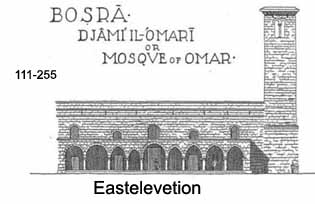 |
aisles on every side of the building,
leaving an oblong space in the middle open to the sky (PL
XVII, Sect, C-D); this will be seen to have been the case
by an examination of the photograph (111. 256) which shows
finished walls and cornices above the arches, and at a
level above that of the adjoining roof slabs. The arches
of the arcades of the aisles at the north and south were
originally parallel, running east and west from one wall
of the building to the other, and at right angles to those
of the east and west aisles which were only two bays long;
but in later restorations this system was altered in the
northeast angle, and the northwest' angle is in |
|
| complete ruins, my plan of this
part being almost wholly conjectural,. The most interesting part
of the mosque, and apparently one of the oldest, is the complete
system of supports between the two southern aisles. This is
shown in 111. 257 and in Section A-B of Plate XVIII. Here we
have in front of the mihrab a broad middle arch, 6.72 m. wide,
slightly pointed, and carried on oblong piers. This is flanked
on either side by three round arches, about 3.70 m. wide,
supported by four slender and graceful columns of cipollino
marble, with capitals of the Corinthian order |
|
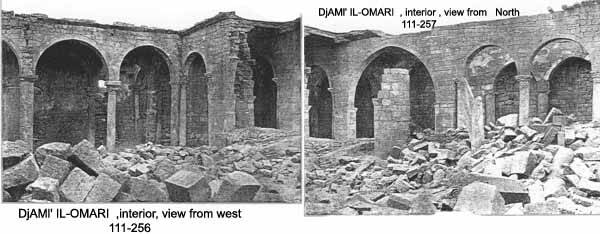 |
|
in white marble. These columns were
taken from some Christian edifice, as an inscription on
two of them will attest, and probably belonged originally
to some Pagan building. The combination of the low pier
and the high column, (x), where the narrow arches join the
broad arch on either side, is a beautiful piece of design.
South of this arcade is a wall arcade quite similarly
designed, but having slightly pointed arches and Ionic
columns of basalt taken from Roman buildings and rather
badly put together. This arcade partly blocks up the
windows in the south wall, and is, I believe, one of the
earlier restorations, having been inserted to decrease the
width of the aisle and to reduce the required length of
roofing slabs. North of the arcade first described was an
arcade similar to it in every detail, but now in ruins.
This was reinforced, at |
|
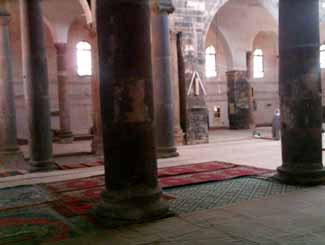 |
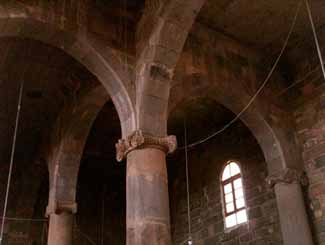 |
|
|
some later period, by an arcade of pointed
arches carried on piers and set directly beside it on the south.
All these later columns and piers are marked (L) on the plan,
and are shown in broken lines in Section C-D. This reinforcing
arcade served, like the wall arcade, to narrow the space to be
spanned by the stone slabs of the roof (111. 256). These two
south aisles extended through the building from the east wall to
the west; the east aisles terminated at the arches of the inner
south aisle. The arches of the first two bays are of unequal
width, both are semicircular, but the narrower is stilted. Their
common support is a column of extreme slenderness in white
marble (Y). The arches of both arcades in these two bays lie
parallel, and north and south. They carry their roofs of stone
slabs intact. The next two columns to the north (Z), and the
column east of it, both in basalt, carried each two pairs of
arches at right angles to each other, in the Gothic manner. |
|
|
| |
| To accommodate this scheme a
third column was placed against the east wall, but this is not
part of a wall arcade. The spring-stones of the fourth arch
carried by column (Z) are to be seen in 111. 256 at the extreme
left. There has been much restoration in the northeast angle,
and the northwest angle is a mass of ruins preserving one broken
column in situ encased by piers on three sides. The north wall
which is nearly intact is 2.50 m. thick, more than double 'the
thickness of the other walls. |
 |
The eastern portico is well preserved. It
begins flush with the south wall of the mosque, but does
not extend as far as the base of the minaret by about 2
metres. It is composed of a row of arches indiscriminately
round and pointed, and carried on the stumps of Ionic
columns taken from the ancient street colonnades. In a
general way the arches are spaced so that the broader ones
are opposite the entrances to the mosque, and that the
narrower arches are pointed (111. 255), but these rules
have several exceptions. The arches carry a corbel course
opposite a similar feature in the wall, and the space
between was roofed with slabs of basalt. It is evident
that this portico is a later edition to the mosque, for it
blocks up the lower half of two important windows. |
|
|
There are five of these
large windows in the east wall, the middle one of which is
pointed; the windows which flank it are set lower in the
wall than those at the ends, and it is these that were
partly closed by the roof of the arcade. The minaret is
about 25 metres high, having a square tower-stair within,
four tall narrow coupled openings of Romanesque appearance
in the top storey, and a complete roof of stone. It does
not belong to the original structure, but is probably an
addition of the twelfth century.
|
 |
|
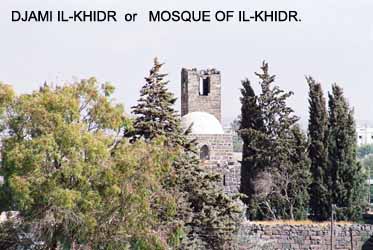 |
DJAMI IL-KHIDR: 1133-34
A. D. This is a small mosque situated near the centre of
the ruins, but well to the northwest of the present
village. It appears incidentally in 111. 205, is in an
excellent state of preservation, but is not in use. Its
plan (111. 259) is very simple, the interior being a
square of 7.40 m. spanned by two semicircular transverse
arches carried on low piers. The walls are 1.10 m. thick,
the doorway is only .90 m. wide, and the little windows
which are set high in the wall are in several cases filled
with stone grilles like those shown in 111. 260. The
minaret which is slightly detached from the main building
is of the same type as that of the great mosque, and
belongs to the same period; the staircase within it is
very narrow, but quite accessible. An inscription in
Arabic gives the date 528 A. H. |
|
|
DJAMI FATMEH :
To the west of the Cathedral, and near the
northern limits of the present village of Bosra, is
this little mosque which is the only one in the
villagenow in use. It has been called by several
names, Djami is-Sala and Dêr il-Muslim , in addition
to the name given above.The building is of the same
type and probably |
 |
|
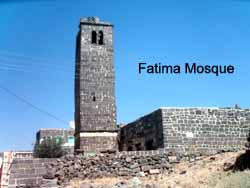 |
|
|
of the same epoch as the Djami
il-Khidr; but in ground plan (111. 261) it is a little longer
and departs from the square. It is spanned by three transverse
arches. The whole building has the appearance of having been
often repaired. As this mosque was constantly in use, I did not
wish to disturb the worshippers by taking measurements inside of
it; and I am therefore indebted to my native assistant, George
Cavalcanty, for the measurements given here. The minaret of this
mosque is detached, and is not exactly placed in the plan
presented herewith. The parapet of its upper storey is partly in
ruins, the call to prayer is given from the windows below. Early
travellers saw the parapet in a perfect state of preservation.
Two panels of a pierced balustrade of white marble are still in
place, supported on either side by posts of basalt. These
sections of balustrade are ancient, probably of Roman date, and
may have come from the Palace. |
|
Id-Dabbaghah: 1225 a. d. This
building, situated near the northeast angle of the great
reservoir called Birket il-Hadjdj, and having its south
wall flush with the wall of the reservoir, was perhaps not
a mosque at all. But it is certainly Moslem work, is dated
in the thirteenth century, and has a mihrab in its south
wall. The name signifies tannery; but whether it was
itself a tannery, or was merely the mosque of the tanners,
or of the quarter of the tanneries, is not clear. The plan
(111. 262) is totally unlike that of any other mosque in
Bosra, or elsewhere so far as my experience goes. It
consisted originally of a long hall spanned by six
transverse, pointed arches (Sect. A-B) carried on short
and slender columns, the third arch from the south end
being carried by piers. |
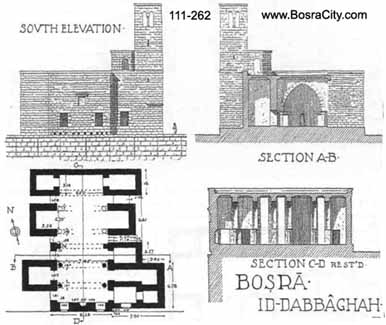 |
|
|
|
| |
|
The three southernmost arches are still
in place although many of the stone slabs they supported have
been carried away. The south and north walls of the building are
heavy, the former is pierced with a mihrab and two doorways; but
the building has no side walls in the ordinary sense, but in
their place a series of square exedras, each detached from the
others, which open upon the long main hall. These almost
independent structures are placed sufficiently near together
(Sect. C.-D.) for the spaces between them to be spanned by the
slabs of the roof, so that the roofing was continuous over all.
This is certainly a very unusual kind of plan. At the southeast
angle the building assumes a more connected plan (111. 263); for
here the minaret is situated, and a low octagonal tower, built
to receive a dome, was placed beside it. The minaret is just
like those described above, but for the fact that it has no
stone stairs and no roof of stone. The south wall of the
building was placed so near the reservoir that corbels had to be
inserted at its base to carry a platform from which the south
doorways could be reached. Between these doorways, but high in
the wall, is a sunken panel with the Arabic inscription upon it
which gives the date 622 A. H. |
|
DJAMI IL-MEBRAK : This mosque, is
situated at the northeast corner of the city, just outside an
obtuse angle in the ancient wall of the town. It seems probable
that part of it at least was built before the Castle, for the
construction of which the city walls were almost entirely
destroyed; since a part of the ancient wall is incorporated with
those of the mosque. The name means the "Mosque of Kneeling" and
has reference to the kneeling of the camel which bore the Koran
upon the spot where this mosque stands. The building is partly
ruinous and partly in a fair state of preservation (111. 264).
It consists of three main divisions, each having its prayer
niche, and several other subdivisions (111. 265). The most
ancient and most sacred part of the mosque is the section on the
west, embracing subdivisions (A) and (B); for in (B), in front
of the mihrab, is the stone upon which, according to the
natives, the historic camel knelt. Some of the people profess at
least to believe that the four depressions in the stone were
made by the knees of the camel. This chamber (B) has for its
west wall a section of the city wall which appears to have been
one side of a redout, as is shown in the plan; but, owing to the
state of the ruins, this has not been definitely determined. Its
north wall, marked "ancient wall" on the plan, is an example of
masonry so beautiful that it might |
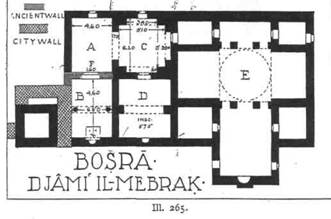 |
be assigned to the Nabataean period;
but, with its inlay of white marble (111. 266) and its
flat carving in imitation of Roman work, is probably to be
assigned to some very good period of Moslem architecture,
specimens of which are sufficiently rare in Syria. The
chamber is spanned by a single transverse arch carried on
columns, but is roofless in spite of its sanctity. Chamber
(A) is an ordinary room opening into (C) by a broad arch.
Chamber (C) is a square bounded by recessed wall-arches,
and may have supported a dome. Chamber (D) is spanned by a
transverse arch; it was filled with straw and was
impossible to measure accurately when I saw it. It is said
to have a prayer niche to the south. The whole of the
eastern section of the building (E) was published by
Professor Brunnow; but parts of it were left as doubtful
in his drawing, Fig. 923. I have found his measurements to
be correct and have embodied them in the plan; but I have
omitted the two chambers flanking the south end of the
main hall, as these do not exist, as may be seen in 111.
264. The cruciform part of the interior was originally
covered with a dome at the intersection, if we read the
old descriptions rightly , The chambers at the four angles
are in two storeys. |
|
|
|
| |
|
|
